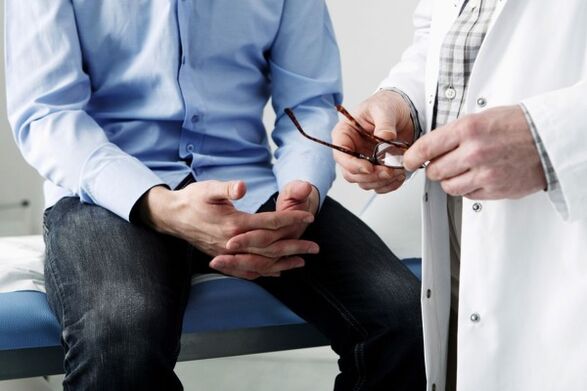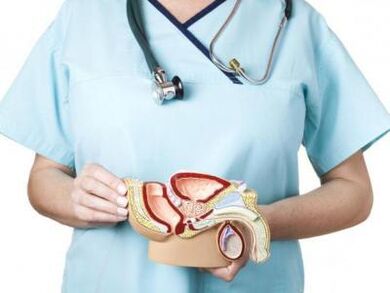Prostatitis is one of the most common urinary system diseases in men. This is impressive even in the context of the fact that the actual number of patients with the disease is much higher than the enrollment statistics. This can be explained by the fact that prostatitis can occur in a latent state and by the peculiarities of the diagnosis.
What does the prostate look like?
.jpg)
It is a small glandular organ. It is located in the pelvic area below the bladder and captures the initial part of the urethra.
The function of the glands is to produce a secret that keeps sperm motility in various adverse conditions, mixing with semen.
What is the male prostate? Prostatitis is characterized by a number of disorders related to the urinary system, erectile function, decreased libido, and other problems.
Lack of prompt and correct treatment has tragic consequences: one in four patients may experience one form or another of infertility because the prostate loses the reliable secretion it produces in the amount needed to secure spermvitality capacity.
The unique symptoms of male prostatitis can appear not only in this disease, but also in prostate adenoma (a malignant tumor)!
Sign
What is the first "bell" of disease? Variability in presentation complicates diagnosis, and therefore, the presence of disease is not always immediately established. The initial symptoms of bacterial prostatitis differ from those of viral origin, and this difference is characteristic of the acute and chronic course of the disease.
At the same time, the main symptoms that should be brought to the attention of patients are:
- Urinating problems. It becomes difficult and painful. This may indicate the first symptoms of exacerbation. The reason is that the inflamed and enlarged prostate blocks the urethra. Failure to take prompt action resulted in worsening health due to complete closure of the ureter.
- sexual disorder. They are characterized by orgasms and diminished erections.
The list of diseases associated with this disease is far from the only one and may only be one of the first signs of deterioration.
In addition to them, the following signs are present:
- excreted from the urethra;
- floating lines in the urine;
- special sensations during bowel movements;
- An unpleasant burning sensation in the perineum.
Diversity is a hallmark of this disease. Therefore, it is necessary to distinguish between the first and acute symptoms of prostatitis in men in the chronic bacterial form.
The cause of prostatitis in men is a sedentary lifestyle, a cold in the genitourinary system.
Characteristics of different forms of prostatitis
The disease can occur in the four most common forms.
Acute bacteria. It is usually diagnosed in patients under the age of thirty. The disease is characterized by fever - prostatitis with temperatures as high as 38 degrees Celsius and above.

Due to prostate edema, the following were observed:
- Acute retention, and frequency and pain of urination;
- lingering discharge;
- discomfort in the groin area;
- Erectile Dysfunction.
Symptoms of sudden prostatitis sometimes include general malaise and apathy.
chronic bacteria. This form is typical for elderly patients. Disease progression is relatively quiet, but may worsen if there are factors causing it. Sometimes the disease is asymptomatic.
non-bacterial. Although it is impossible to detect the presence of bacteria, this situation does not rule out their presence.
Prostate pain. It is characterized by the compaction of prostate tissue in which there are no symptoms of inflammation.
how to determine
The disease must be identified before an effective treatment can be prescribed.

In diagnosis, an integrated approach is important:
- Collect medical records. To get a reliable picture of the disease process, the doctor will find out: the nature of the pain, the presence of secretions, sexual problems. A rectal finger analysis is done to help reveal the extent of prostate swelling and pain.
- laboratory research. Often, without them, it is impossible to identify the disease. This is especially true for chronic bacterial prostatitis. To find out the cause, a urine culture is required, which can help identify the pathogen causing the exacerbation. Compare the reliability of three urine samples. A biopsy and analysis of secretions may sometimes be required. Venous blood was also analyzed for ESR content and leukocyte count.
- Ultrasonography. Tomography (Computed and Magnetic Resonance Imaging). The studies were performed on the prostate and adjacent organs.
how it is treated
important! Medications are prescribed by a urologist. Do not engage in "self-designation" - it will only aggravate the disease!
There are many ways to treat men's diseases in modern times. Prostate can be completely cured if you seek medical attention in time.
The choice of form and method is consistent with the level of complexity, the timing of the onset of the disease, the patient's state of health and his physical characteristics.
Appointment for the procedure depends on this and can be done in an outpatient clinic or hospital.
Treatment regimens for acute and chronic prostatitis exacerbations are virtually similar. Through timely and adequate treatment, the acute type is completely cured, and the chronic type achieves long-term remission.
important! Illness wins only with a comprehensive approach - don't ignore any doctor's advice!
medical treatement
Medications include antibiotics, nonsteroidal pain relievers, and alpha-blockers. The former is often used to treat bacterial forms.

During the chronic course of the disease, alpha-blockers are prescribed to reduce prostate edema and relieve pain.
important! It is recommended to use the pill for the entire duration, usually for at least six months, and not to stop early even if you feel better.
Non-steroidal drugs - used to treat acute forms.
massage

It is considered an effective treatment. It improves blood supply to glandular tissue and when combined with other treatments it greatly increases the effectiveness of antibacterial and topical treatments.
Thanks to digital stimulation, it promotes the excretion of prostatic secretions and thus further self-excretion through the urethra.
Although patients often experience discomfort during surgery, ignoring massage is not recommended.
attention! In the case of the acute form of the disease, massage procedures are prohibited - this is full of the spread of infection!
Reflexology
With the help of acupuncture and other methods, the work of the central nervous system is improved, blood flow and metabolic processes in the body are normalized. Reflexology helps relieve neuralgia and prevents the development of inflammatory processes. This procedure is recommended in conjunction with other treatments.
Leech Therapy
The method also finds application in the treatment of prostatitis. The use of leeches helps increase blood and lymph flow to the prostate and normalize its function.
rectal suppository
They directly affect the lesions, so they are a very effective remedy. It contains antispasmodics, anabolic steroids, antibacterial substances that are good for preventing exacerbations.
The efficacy of fishy alcohol and sea buckthorn suppositories is very high.
immune correction
Every patient with this condition is advised to strengthen their immune system. This helps to increase the body's resistance and helps to slow down the progression of chronic prostatitis exacerbations. The complex should use:
- Natural methods - active physical activity, walking in fresh air, hardening;
- Natural immune modulators - ginseng, echinacea, etc. ;
- Multivitamin complex.
operation treatment
At one point, they were often treated with surgery. However, in some cases, it does not bring high efficiency. In recent years, surgical procedures are mainly used for prostate abscesses or urethral strictures.
Thirty is already a reason to consider health. Prostatitis occurs in every third of patients over this age limit, and every second after age 50. And this trend has continued to this day.
Now that you know the first signs of prostatitis in men and how to treat it, in order to prevent the disease from further turning into a chronic form, you need to have regular check-ups with your doctor so that it can be detected in time. What to do with prostatitis, every patient should know where to go.






























